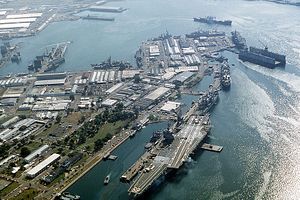The Philippines and the United States on Friday reached agreement on a new security accord which will expand military cooperation between the two old allies and allow the United States military to share local bases with the Philippines armed forces for maritime and humanitarian operations. As The Diplomat reported last month, the deal has been under negotiations for some time now.
According to Reuters, the agreement will be a highlight of President Barack Obama’s upcoming visit to Manila from April 28-29, when he is expected to sign the final draft. Pio Lorenzo Batino, Undersecretary of Defense and chair of the Philippine negotiating panel, said that the two countries had reached consensus on “key points.” “The draft provisions on key points of an enhanced defense cooperation will be submitted to the president for his review,” Batino added in a statement.
In general, despite remaining allied with the United States, the Philippines has not allowed the U.S. military to operate out of bases in the country since expelling U.S. forces from Subic Bay in 1992. At that time, Subic Bay was the headquarters of the United States’ Seventh Fleet. Since then, Washington has been involved in limited counter-terrorism operations in the Philippines. The renewed push in the Philippines to invite the United States back to share bases is due to the rise of China and concomitantly the increase in tensions between Beijing and Manila over disputed territories in the South China Sea. The deal therefore is in the interest of both the United States and the Philippines. For the Philippines, inviting U.S. forces to share bases will offer a bulwark against Chinese aggression should it ever occur. For the U.S. Navy, adding basing facilities in the Asia-Pacific will give it more flexibility in conducting a variety of operations around the region, including humanitarian missions and search and rescue. Indeed, the U.S. Navy cooperated heavily with the Philippines following last year’s devastating Typhoon Haiyan.
When the deal is signed, it will allow the Obama administration to rebuff critics that it has failed to take the re-balance to Asia seriously. The move is likely to be reassuring to U.S. allies in the Asia-Pacific region as well. The Philippines can at least take solace in the fact that the United States will be there to back it should its territorial disputes with China lead to any sort of conflict. Jose Cuisia, the Philippine Ambassador to the United States, said “No, I don’t think there should be any doubts to the U.S. rebalance to Asia.”
Operationally, the agreement is likely to result in the U.S. Navy carrying out additional surveillance missions in the South China Sea. A key feature of this agreement is that is not a basing agreement; the U.S. military’s presence in the Philippines will not be like its presence in South Korea and Japan, where the United States maintains a massive troop presence on a permanent basis. In this case, U.S. access to Philippines facilities is contingent on the invitation of the Philippines. The agreement simply provides a basis on which the two countries can cooperate to that end. There are also restrictions on what kind of equipment the United States can bring into Philippines facilities; nuclear weapons are notably prohibited by the agreement.

































